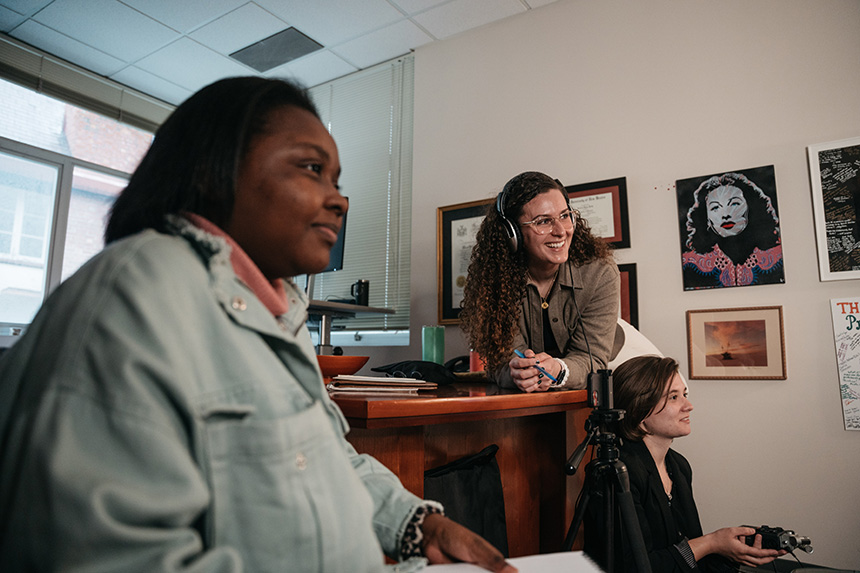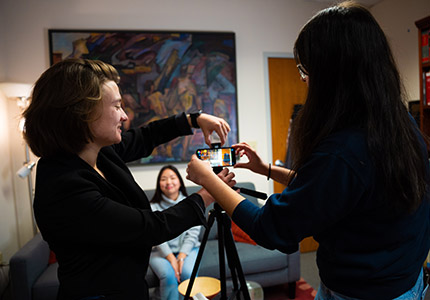
By Sarah Weld
When Leah Roemer ’23 and Sophie Hoblit ’23 enrolled in Berkeley Law’s Death Penalty Clinic last fall, they envisioned spending all year working on legal briefs for clients on death row. Instead, they found themselves behind a camera making a video to request clemency for a longtime clinic client.
This is the 22-year-old clinic’s first foray into the growing video defense strategy, which gives attorneys a way to be creative outside the rules and restrictions of formal legal pleadings. The clinic is preparing the request for clemency — the process by which a governor, president, or administrative board can reduce a defendant’s sentence or grant a pardon — in case litigation options fail.

“Once you get to this stage of proceedings in a state like Alabama, the traditional approaches have not worked, so we need to be creative,” says Supervising Attorney Mridula Raman, who will give a presentation on “Storytelling in Capital Clemency Campaigns” at an upcoming conference in London. “Having avenues to try different things is really helpful. But it’s not even a choice at this point. We have to think outside of the box to stand a real chance.”
Roemer, Hoblit, and their four teammates — classmates Dan Hilborn, Katie Melnick, Paloma Sat-Vollhardt, and Monica Van — built on the extensive work of clinic students from prior years, delving further into genealogy as well as juvenile justice and early childhood education records.
They traveled frequently to San Bernardino County, California, and Alabama, where each spent hours meeting with their client (who can’t be filmed or photographed in prison) and interviewing witnesses in person. The video includes interviews with a family member, a childhood family friend, a juror, and an expert witness, plus photos and papers documenting their client’s childhood abuse.
Humanizing the appeal process
“When you’re going through appeals, you rarely get the opportunity to put faces and voices to these characters in the story. Seeing someone and hearing them speak is harder to ignore than a dry stack of papers,” says Roemer, who will be a fellow at the Death Penalty Information Center this fall, researching and writing a report on prosecutorial misconduct in capital cases. “There aren’t any rules for where we are in our client’s case, so we’ve taken advantage of that by doing this direct, captivating video. We’re able to develop a more robust clemency petition because we have the luxury of time and manpower in the clinics.”
Unlike some public defender offices that might not have the bandwidth or resources to make videos, the clinic welcomes a new crop of students every year. Roemer and Hoblit worked with their four student teammates, Raman, and Co-Director Ty Alper to produce the video, which the clinic will have ready if its client receives an execution date.

“Our client’s story is incredibly distressing, moving, and compelling, and we thought it would be best conveyed visually. You can convey a lot more in two minutes on film than in many pages of reading,” Raman says. “We have the time and resources to be creative and do things that not every team can do. It’s the benefit of having a clinic involved.”
Adding video as a strategy makes sense for the clinic, which is also exploring nontraditional approaches for another longtime Alabama client. Alper and Raman note that using video to tell a client’s story is part of a nationwide trend fueled by easily accessible technology and the widespread use of short videos on everything from TikTok and Instagram to traditional media outlets.
“It dovetails really nicely with the nontraditional advocacy happening in some of our other cases. Above and beyond it being an opportunity for us to advocate in a more effective way for our clients, it’s a cool opportunity for the students to see a different side of what it can mean to be a lawyer,” Raman says.
The students worked directly with award-winning documentary film editor Nels Bangerter, husband of Berkeley Law Professor Saira Mohamed, who spent several hours each semester lending his expertise to the project.
“The students were extremely thoughtful about the project’s audience, and they tuned their efforts toward making a video that would not only present a compelling argument, but do so in a deeply humanistic way,” he says. “This clemency video hopes to have an effect almost beyond the furthest reach of the legal process. It’s got to work on the head and the heart.”
Connecting advocacy with emotion
In making the video, the students say they learned how to cultivate continuing relationships, put witnesses at ease on camera, tell a compelling story in a tight timeframe, and allow their emotions into the work.
“People have such different beliefs about the death penalty and who deserves to be incarcerated. You have to approach everyone you meet with an openness and a delicacy,” says Hoblit, who worked as a broadcast associate on the true crime show “48 Hours” and will be an associate at Paul Hastings in the fall. “Learning how to read and navigate people when you’re first meeting them is really important. When you’re strictly doing more standard legal work, sometimes you have to leave your emotions separate. It’s been really helpful for the video to let those emotions come in.”
Alper and Raman say that the creativity needed to make videos could also enhance the clinic’s more traditional legal strategies.
“We are always telling stories in our litigation, but this is storytelling in a new, unconstrained way that has been really interesting and exciting,” Alper says. “Our hope is that this more creative storytelling might also make us better at the more traditional storytelling we do. We’re still going to be constrained when we write legal pleadings. But if we think about how we could tell the story if it was in a film that we have complete control over, where there aren’t any rules, that might open up our imaginations to infusing some of those new ways of storytelling into more traditional forms of advocacy.”